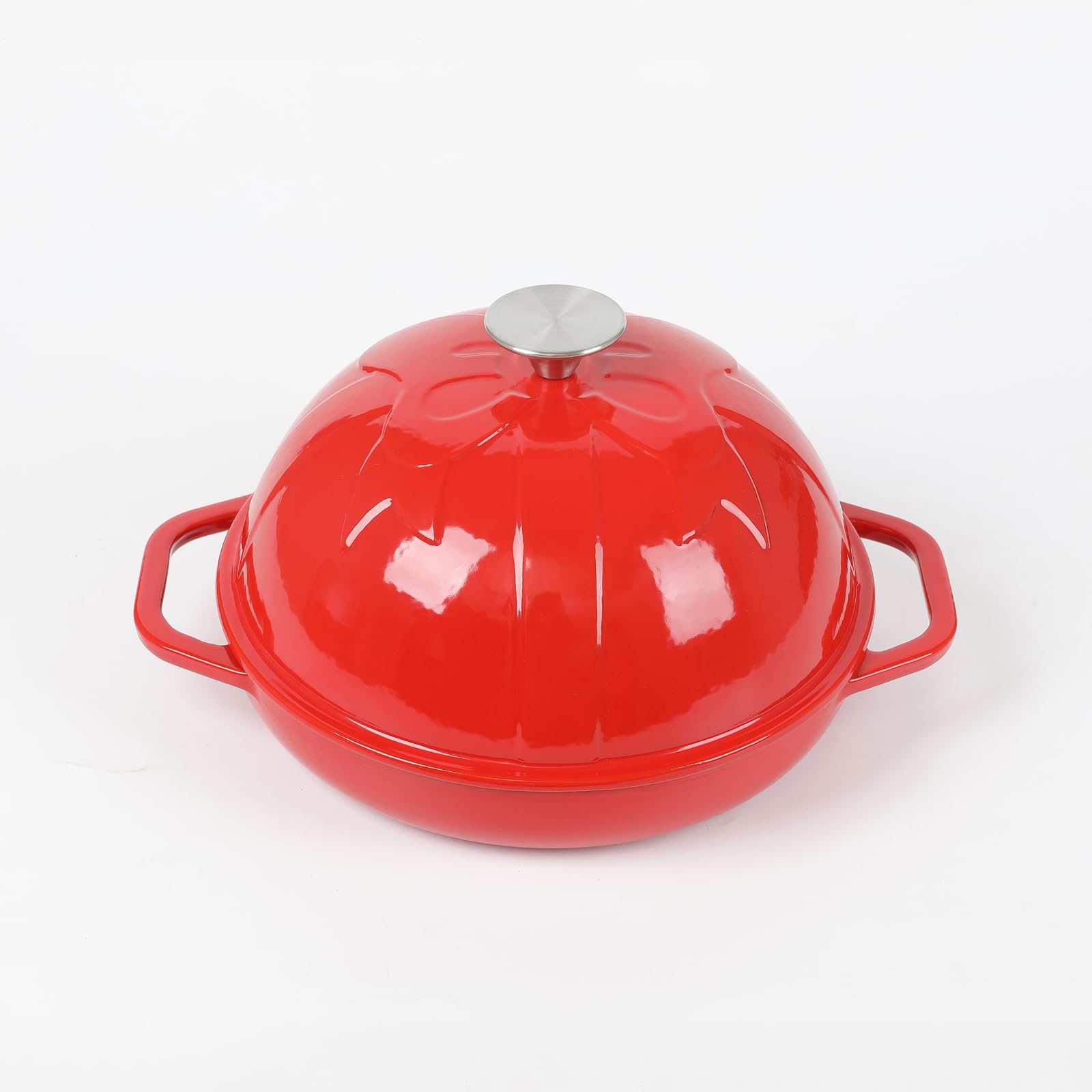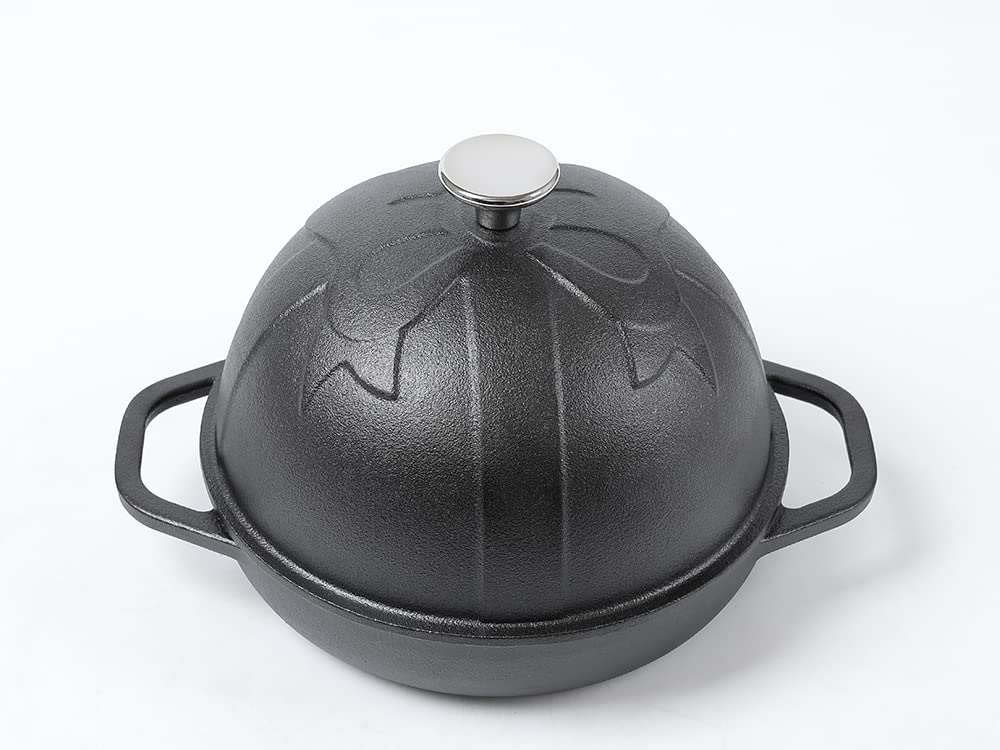Bread baking is an art cherished throughout history, and modern home bakers continue to embrace this tradition. Part of the bread-baking process involves creating the perfect crust and crumb, and this is where a bread cloche comes into play.
A bread cloche is essentially a baking dome, typically made from materials such as ceramic or cast iron, which traps moisture and mimics the environment of a steam-injected oven. This is crucial because the steam gives the bread a crispy, golden crust, and soft, tender interior.
As an avid home baker, I understand that choosing the right Dutch oven and bread cloche can make all the difference in baking. It’s not just about the shape; the material of the bread cloche significantly affects heat distribution and retention, which impacts the texture and flavor of the bread.
Some of the best bread cloches are ceramic due to their heat retention, while cast iron versions excel at distributing heat evenly. Size is also important, as it must match your baking needs—making small boules or large family-sized loaves.
When considering a bread cloche, I pay attention to the quality of the materials, the ease of handling, and how well it can fit into my oven without crowding. A well-fitted lid is also essential to keep the steam contained.
After testing various models and taking notes on their performance, I’ve narrowed down the best bread cloches that consistently produce superb artisanal-quality bread right at home. My kitchen has become a bread paradise, and your home could be next as I share my findings.
Best Bread Cloches for Home Bakers
I’ve learned that using a bread cloche can take your home-baked bread to the next level. It’s an essential tool miming a professional steam-injected oven, giving your vegan bread a perfect crusty exterior and a soft, airy interior.
Whether you’re an experienced baker or just starting, I’ve rounded up the best bread cloches to help you make delicious loaves every time.
Emile Henry Cloche
I’d say go for it if you’re a bread enthusiast looking for that perfect crust and fluffy interior.
Pros
- Dual-purpose lid can be used as a mixing bowl
- Creates a bakery-quality crust with excellent humidity control
- Simple to clean with its non-stick surface
Cons
- Heavier than expected, might be an issue for some
- Needs careful handling to avoid chipping ceramic
- Premium price tag for a specialized kitchen tool
After my first baking session with this stunning burgundy bread cloche, I’m pretty smitten. The beauty of its ceramic build isn’t just for looks; it’s crafted to replicate the humidity of a traditional bread oven.
Flip the cloche’s lid, and you have a mixing bowl for your dough. It was a breeze to tidy up, thanks to its high-resistance glaze. The criss-cross pattern wasn’t just for aesthetics and helped get rid of sticking.
However, there was a learning curve to handle the weight of the high-quality ceramic, especially when hot. While it seems quite durable, I’m always careful with ceramic ware due to its vulnerability to chips or cracks if mishandled.
HAWOK Yellow Enameled Cloche
I’d recommend this lovely cloche for anyone who enjoys fresh, crusty bread made in small, manageable batches.
Pros
- Perfect for single or double servings
- Durable cast iron with even heat distribution
- Non-stick and easy to clean
Cons
- Too small for large families or parties
- No recipes included for beginners
- May require trial and error for temperature adjustments
Recently, I decided to bake a small, tasty loaf using the HAWOK Yellow Enameled Cloche, and the experience was delightful. Its sturdy, cast-iron build radiated a steady warmth, and the non-stick surface lived up to its promise.
This cheerful cloche added a pop of color to my kitchen while it crafted my artisan bread. The ridges on the base, meant to leave a whimsical pattern, also promoted an even browning that I found quite pleasing.
On the flip side, those planning to feed a larger group might find it too small. I also noticed that it came without a guide or recipes, which might be a hurdle for novice bakers.
Potted Pans Sourdough Special
If you’re seeking an artisanal touch in your kitchen, the Potted Pans Sourdough Special could be your new favorite baking companion.
Pros
- Ensures a moist and chewy bread interior
- Offers a deep base for versatile stovetop use
- Safeguard feature to handle dough easily
Cons
- Limited to one bread size
- Requires careful maintenance of the cast iron
- Might be heavy for some users
The Potted Pans Sourdough Special truly transformed my bread-making experience. The low-profile base of this cloche is a game-changer; it allows for easy transfer of the dough into the pot without worrying about a burn, a detail I deeply appreciate.
I’ve also found the dual-use base quite practical. On days when bread isn’t on the menu, I use it for cooking my favorite vegan stews right on my stovetop. Its enameled cast iron material ensures even distribution of heat.
However, this is designed for loaves up to 10 inches, so my larger sourdough ambitions must be curtailed. And, anyone familiar with cast iron knows it requires a bit of love and care to maintain its non-stick properties.
HAWOK Cast Iron Bread Cloche
If you adore making sourdough or any artisan bread at home, this cloche will elevate your baking with its even heating and superior crust development.
Pros
- Makes cleaning a breeze with its non-stick enamel interior
- Produces a crispy crust with a professional-looking lollipop design
- Dual-function base can be used as a skillet for plant-based dishes
Cons
- It’s relatively heavy, making it a bit cumbersome to handle
- Requires hand washing, which might not appeal to everyone
- Due to its cast iron nature, it demands careful maintenance to prevent rust
Since I got my hands on the HAWOK Cast Iron Bread Cloche, my sourdough loaves have come out with that perfect bakery-style thick, crisp crust that I’ve been striving for. The non-stick enamel coating makes transferring the dough into the cloche less tense.
During my first use, I noticed the heavy-duty cast iron really does its job well, distributing heat evenly for a consistent bake. After the bread is done, I love letting the cloche cool down before wiping it clean—no scrubbing necessary.
Just a heads up for fellow bakers: this cloche is hefty. And while the maintenance isn’t overwhelming, remember that it can’t go in the dishwasher, and you’ll want to keep it perfectly dry to ensure its longevity.
HAWOK Sourdough Cloche
The HAWOK Cast Iron Bread Cloche is a true game-changer for home bakers striving for that perfect sourdough boule.
Pros
- Creates a crispy crust and moist interior
- Sturdy cast iron material retains and distributes heat evenly
- Multi-functional design usable as a skillet
Cons
- The base may be too shallow for larger loaves
- Hand wash only, not dishwasher-safe
- Heavy and may be challenging to handle for some
I’ve found the HAWOK Bread Cloche elevates the quality of my homemade sourdough. Its knack for heat retention means a consistently well-cooked loaf with just the right amount of crunch in the crust. Plus, the cast iron is so robust I’m sure it will be a part of my baking arsenal for years.
Navigating the kitchen with this cast iron bread cloche has been a breeze, thanks to its ergonomic handles. When I’m not baking, it doubles as a skillet on the stove, perfect for vegan sautés and grills.
However, since it’s not dishwasher safe, I have to wash it by hand. And while it’s a hefty piece of kitchen equipment, the weight ensures even heat distribution, so I’m more than happy to handle it with care.
Emile Henry Artisan Bread Baker
Having just baked another beautiful loaf, I can confidently say that this bread cloche is a gem for any baker looking to elevate their bread game.
Pros
- Even heat distribution for consistent baking
- Durably made with high-resistance ceramic
- Easy to handle and clean
Cons
- No handles, which makes handling when hot tricky
- Heavy lid that requires extra caution
- Size might be bulky for smaller kitchens
When I first laid my hands on the Emile Henry Artisan Bread Baker, I was struck by the quality. Its weight is reassuring – it feels sturdy and robust. The breads I’ve been churning out have a fantastic crust, which I attribute to the cloche’s excellent heat retention.
Indeed, the lack of handles was initially unsettling. I’ve learned to be extra cautious, especially when removing the hot lid, as the steam that escapes can be quite intense.
The cleaning aspect is a victory in itself. I place it in the dishwasher, and it comes out looking as good as new, no scrubbing necessary. After several uses, it’s still free of scratches, reinforcing the durability claim.
READ NEXT: Best Affordable Dutch Oven: Ultimate Picks for Budget-Friendly Cookware in 2024
Buying Guide
Material
I always check the material first. The most common materials are ceramic, clay, and cast iron. Ceramic and clay offer excellent heat distribution, and cast iron has superb durability but poor heat retention.
Size
Size matters based on the amount of bread I plan to bake. I look for a cloche that easily fits in my oven and has enough space for my desired loaf size.
Shape
Round and oval are the typical shapes available. I consider which shape best suits the types of bread I bake most often.
Dome Height
The dome’s height is crucial—it must allow the bread to rise properly without touching the top. A taller dome is great for bread that rises significantly.
Handles
I look for handles because they make it easier to transfer the hot cloche safely. Ensure they’re sturdy and provide a good grip.
Lid Design
A tight-fitting lid is key for trapping steam and getting a nice crust. I check to make sure the lid seals well but is also easy to lift off.
Maintenance
Checking the cleaning instructions is essential for me. I prefer bread cloches that are easy to clean, with no intricate designs that trap dough and flour.
Price
Finally, I weigh the price against the features and durability. More expensive doesn’t always mean better, but it’s often a good quality indicator. It’s about finding the right balance for my budget.








